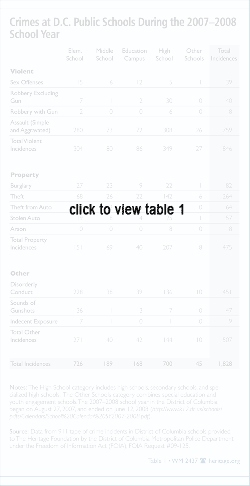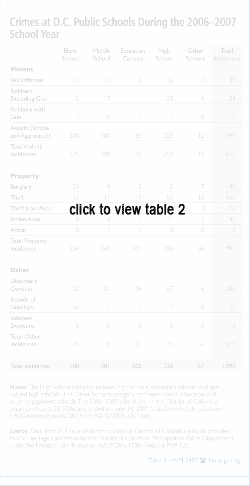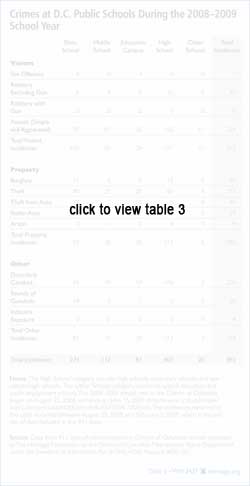Congress will soon hold hearings to consider the future of the D.C. Opportunity Scholarship program, the federal initiative that currently helps 1,700 low-income students attend private schools in Washington, D.C. After five years, federal policymakers have an opportunity to evaluate the evidence about this program's impact on the educational opportunities for participating students to determine whether more scholarships should be made available.
In order to evaluate the program's impact, many policymakers have focused on whether participating students are improving academically. In March, the U.S. Department of Education's (DOE) Institute for Education Sciences released the results of a federally mandated evaluation that found that, after three years, students who were offered and used scholarships had made statistically significant improvement in reading achievement compared to the control group students who were not awarded scholarships.[1] The evaluation found that students using scholarships through the program were performing approximately 3.7 months ahead in reading than students who were not using scholarships. Moreover, the evaluation reported that students who had been participating in the program the longest had made greater progress than the control group in reading -- a gain that amounted to nearly two school years worth of additional learning.
Impact on School Safety
While many have focused on the program's impact on academic achievement, the DOE evaluation also studied how the program has affected students' educational experiences in other ways. For example, the DOE study examined how the program has impacted parents' and students' views on school safety and school climate. Past evaluations have reported that school safety was an important reason why families chose to participate in the Opportunity Scholarship program.[2] The 2009 evaluation reported that 17 percent of the first cohort of parents participating in the scholarship program listed school safety as their most important reason for seeking a scholarship -- the second-most-cited reason to academic quality.[3]
After three years, the latest evaluation has found that the experience of participating in the scholarship program has improved parents' confidence in the safety and climate of their children's chosen school. According to the DOE evaluation, "Overall, treatment group parents rated their child's school significantly higher regarding safety and an orderly climate than did control group parents."[4] However, the evaluation found no difference in students' views of their schools' safety and orderliness.[5]
What the Evidence Suggests about School Violence and Safety in D.C. Schools
The importance that participating families place on their children's safety in school suggests that the issue of school climate should be one of the factors policymakers consider when evaluating the effectiveness of the D.C. Opportunity Scholarship program. That participating parents are more likely to believe their children's schools are safe suggests that the program is benefiting participants. However, policymakers should also consider the available evidence and data about the safety of schoolchildren in Washington, D.C.
Past Data on School Violence and Safety in D.C. Public Schools
Historically, available data suggests that the D.C. public school system is among the most dangerous in the nation. The DOE's 2007 report Indicators of School Crime and Safety: 2007 found that, in 2005, 12.1 percent of D.C. students in grades 9 through 12 "reported being threatened or injured with a weapon on school property during the previous 12 months." This percentage is higher than any state and significantly higher than the national average of 7.9 percent.[6]
Similarly, the report found that, in 2005, 15.2 percent of high school students in D.C. "reported having been in a physical fight during the previous 12 months" -- more than any state or the national average of 13.6 percent.[7] A 2007 report by The Washington Post found that nine violent school incidents are reported on a typical day in D.C. schools.[8]
Findings from a 2009 Freedom of Information Act Request
In November 2008, The Heritage Foundation submitted a Freedom of Information Act (FOIA) request to the Metropolitan Police Department seeking records of crime incidents in D.C. public, private, and charter schools. Information on the school's name and address, the date and type of incident, the criminal complaint number, and any available descriptive characteristics were requested for each incident occurring in a D.C. school since August 2006. The request was fulfilled with a dataset of 911 calls received for crime and emergency incidences in D.C. schools. The data covers the period beginning January 1, 2006, and ending February 5, 2009.
This allows for analysis of two full school years of incidences (2006-2007 and 2007-2008 school years) and incidences occurring during the first half of the 2008-2009 school year. Information on the date of the incident, the event number, the type and description of the incident, address, and location was included in the dataset. Once received, information on the schools type (elementary, middle school, high school, private, charter, etc.) was added to the dataset.[9]
More than 25,000 observations documenting more than 300 different types of crime and emergency incidences in D.C. public, charter, and private schools were included in the dataset. Table 1 shows a subset of these reported incidences occurring in D.C. public schools that were responded to by the Metropolitan Police Department during the 2007-2008 school year. Data for the 2006-2007 and the first half of the 2008-2009 school years are in Tables 2 and 3, appearing at the end of the paper.

Interpreting This Data
The data received does not include any information on whether charges were filed or an arrest was made in response to the reported incident. The data documents 911 calls made from and responded to at D.C. public schools. This data includes calls for assistance made in response to a concern over an incident but without proof of an actual crime. Therefore, some of these incidences may be unfounded -- they were called in, but upon arrival of a police officer and investigation of the complaint, it was determined that no actual crime was committed. Also, it is very likely that other incidences occurred and were not reported to the Metropolitan Police Department. It is important to keep both of these points in mind when interpreting the data presented in this paper.
What is apparent from the data is that students attending D.C. public schools are exposed to a variety of incidences of crime in school, exposure that likely has a negative impact on feelings of personal safety and the schools' learning environment. During the 2007-2008 school year, a total of 1,828 incidences of crime were reported to 911 from D.C. public schools, including 846 incidences of violent crime, 475 property incidences, and 507 other incidences. Elementary schools reported 726 incidences of crime, middle schools reported 189 incidences, and high schools reported 700. To put these numbers in context, there were 29,069 students enrolled in elementary schools, 5,389 in middle schools, and 13,631 enrolled in senior high schools during the 2007-2008 school year.[10]
Empowering District Families
The data presented here of incidents of violence and crime in D.C. public schools confirm that safety continues to be a problem in the District's education system. The data support D.C. parents' belief that improving the safety of their children's schools is a reasonable priority when trying to exercise school choice. Members of Congress and the D.C. City Council should recognize the persistent problem of school violence and crime in public schools in the nation's capital. Consequently, policymakers should empower all District families with greater power to choose a safe school environment for their children.
Shanea J. Watkins, Ph.D., is Policy Analyst in Empirical Studies in the Center for Data Analysis, and Dan Lips is Senior Policy Analyst, at The Heritage Foundation.




